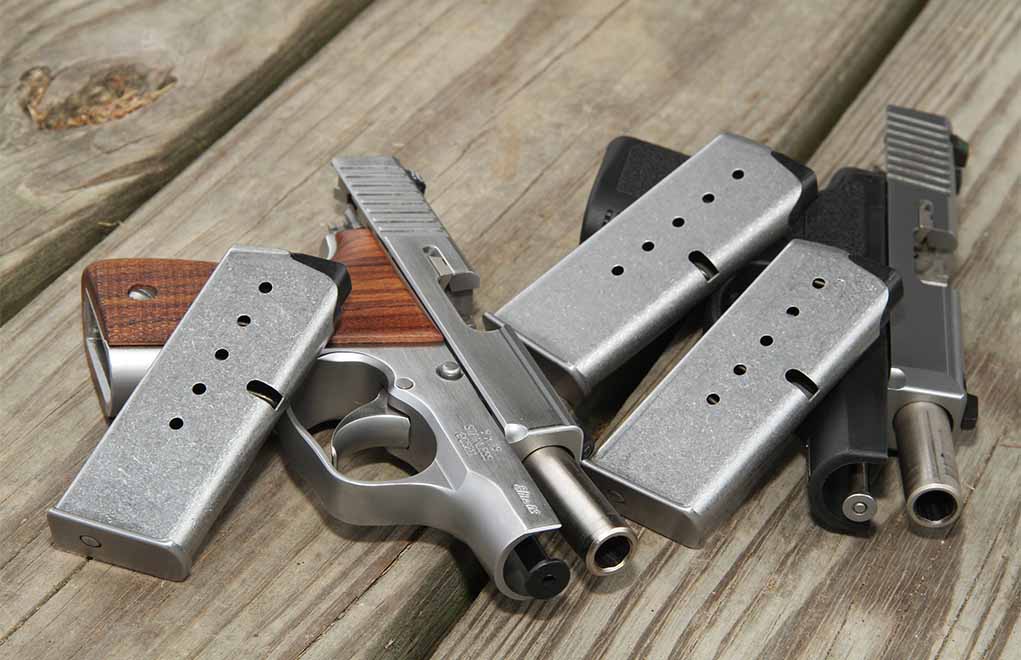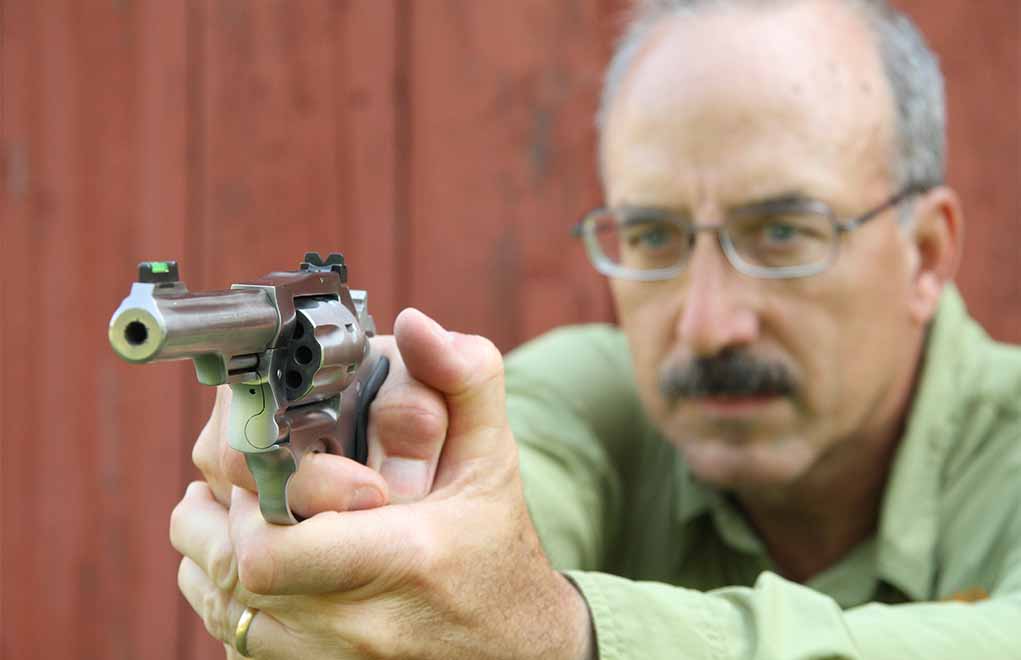

Despite its longevity, the wheelgun continues to be misunderstood. We set the record straight on seven of the most common misunderstandings concerning revolvers.
What Are The Revolver Myths:
What Are The Revolver Truths:
- They Are The Lowest-Cost Practice To Be Had
- They Do Not Depend On Magazine Springs
- They Are Accurate
- They Offer A Wider Power Range Than Pistols
Despite the inroads pistols have made, there’s still a place for revolvers as carry guns, and a lot of people carry them. But, we need to make sure you don’t walk around in a fog of misconceptions about revolvers—because a lot of gun store guys are not as up on their wheelgun knowledge as you (and they) might think.
Myth #1: Revolvers Never Jam
As someone who has carried revolvers off and on for some 40 years now and competed with them for 30-plus years, that just ain’t true. You can have a bullet jump forward on recoil, stick out the front of the cylinder and prevent rotation. You can have unburned powder flakes fall under the extractor star on a reload so that you can’t get the cylinder closed. Heck, I even flat-out broke a revolver at the IPSC World Shoot in Greece and had to finish with a loaner.
If it’s made by the hand of man, it can break.
Myth #2: They Are Both Easy And Difficult To Shoot
Easy, as in “all you have to do” is squeeze the trigger. And hard, because “the trigger pull is heavy.” Yes, a double-action revolver is easy in concept. Squeeze, repeat. But most people don’t squeeze; they clutch. And the jerky slapping of the trigger is what causes them to miss.
Stroke smoothly through the trigger and don’t anticipate the loud noise to come, and you will hit what you aim at. Doing it quickly is a matter of repetition in practice.
Myth #3: They Are Always Slow To Reload
I’ll admit that, compared to a pistol, it does take more time to get the ammo supply topped up in a revolver. But you can speed up that process. The exemplar here (and pretty much in all things revolver) is Jerry Miculek. He can reload a revolver faster than most pistol shooters can reload their 9mms. It is a matter of practice and proper technique. That so many revolver shooters are so bad at it is more a matter of not having been taught right than any inherent inadequacies of the wheelgun.

If you are using a concealed carry revolver, you can learn from police from decades ago: the “New York Reload.” Simply put—a second gun. Rather than try to stuff five or six more rounds into the now-empty gun, drop it, draw the backup, and continue solving your problem.
Truth #1: Revolvers Are The Lowest-Cost Practice To Be Had
You can practice at zero cost. It is called “dry-firing”; and, unlike with pistols, you don’t have to break the sequence to re-cock the striker or hammer. You simply double-action-stroke the trigger again and again. Thousands and tens of thousands of repetitions of the DA stroke not only strengthen your hand and improve your aiming, they also smooth the parts. Called “burnishing,” it is the polishing of metal surfaces by rubbing them against each other. A revolver that has been dry-fired a bazillion times (and not abused) has a trigger feel that is really smooth.
Mike Karbon, the owner of the gun shop I started at, dry-fired his Colt Python so much that he broke the firing pin. Even Colt was amazed at that. When it happened, I did a quick estimate of how many times a day I heard click-click-click and realized Mike had done hundreds of thousands of dry-fires. A new firing pin was cheap practice, and not all revolvers will break a pin, even under that volume of clicking.
Truth #2: They Do Not Depend On Magazine Springs
This is not as big a thing as many people make it out to be … but it is a thing. No, leaving your magazine (a good one, anyway) loaded for long periods of time is not a problem. It will work. I have personal knowledge of magazines left loaded for not fewer than 17 years, and they worked just fine.
Take Another Spin With Our Revolver Content:
- 7 Standout Concealed Carry Revolvers For Personal Defense
- Double-Action Revolver: Secret To The Trigger
- FBI Handguns: Revolvers of the Past
- Colt Python: The Cadillac Of Revolvers
Nevertheless, you are still depending on a magazine and its spring. With a revolver, the five or six rounds that rest in the chambers do not depend on springs to the extent that a pistol does. Yes, there are springs involved, but the coil or leaf spring in your revolver will be up to its task for centuries to come.
Truth #3: They Are Accurate
A pistol depends on the relationship between the slide and the barrel for accuracy. If the barrel does not come to rest in the slide in a consistent manner, accuracy will suffer. On a revolver, the sights are firmly fixed to the frame and barrel, and they don’t move. As long as the cylinder comes up in line with the bore in a reasonably consistent manner, you have accuracy. As a result, even an inexpensive revolver will be accurate. And the best are brilliant at it.

Truth #4: They Offer A Wider Power Range Than Pistols
Both go down to the lowly .22 LR in power. Pistols max out at the .45 ACP in the usual designs, with some going up to .357 Magnum, .44 Magnum and bigger. Big-bore revolvers start at the .357 Magnum and go up from there—up past the .44, to .480 and .50. It is easy to find a gun shop with a selection of .44 Magnum revolvers, but try finding a gun shop with an equal selection of equal-powered pistols.
The important thing to keep in mind is this: Revolvers and pistols are not better or worse than each other. They are different. Each has strengths and weaknesses. Learn about them and learn to shoot them, because your level of practice and preparedness is more important than the particular type of gear you are carrying.
The article originally appeared in the August 2019 issue of Gun Digest the Magazine.

Next Step: Get your FREE Printable Target Pack
Enhance your shooting precision with our 62 MOA Targets, perfect for rifles and handguns. Crafted in collaboration with Storm Tactical for accuracy and versatility.
Subscribe to the Gun Digest email newsletter and get your downloadable target pack sent straight to your inbox. Stay updated with the latest firearms info in the industry.

![Best Concealed Carry Guns In 2025 [Field Tested] Wilson Combat EDC X9S 1](https://gundigest.com/wp-content/uploads/Wilson-Combat-EDC-X9S-1-324x160.jpg)


![Best 9mm Carbine: Affordable PCCs [Tested] Ruger Carbine Shooting](https://gundigest.com/wp-content/uploads/Ruger-Carbine-Shooting-100x70.jpg)
![Best AR-15: Top Options Available Today [Field Tested] Harrington and Richardson PSA XM177E2 feature](https://gundigest.com/wp-content/uploads/Harrington-and-Richardson-PSA-XM177E2-feature-100x70.jpg)
